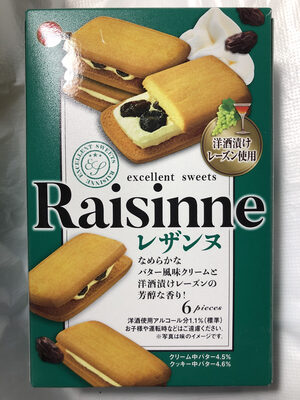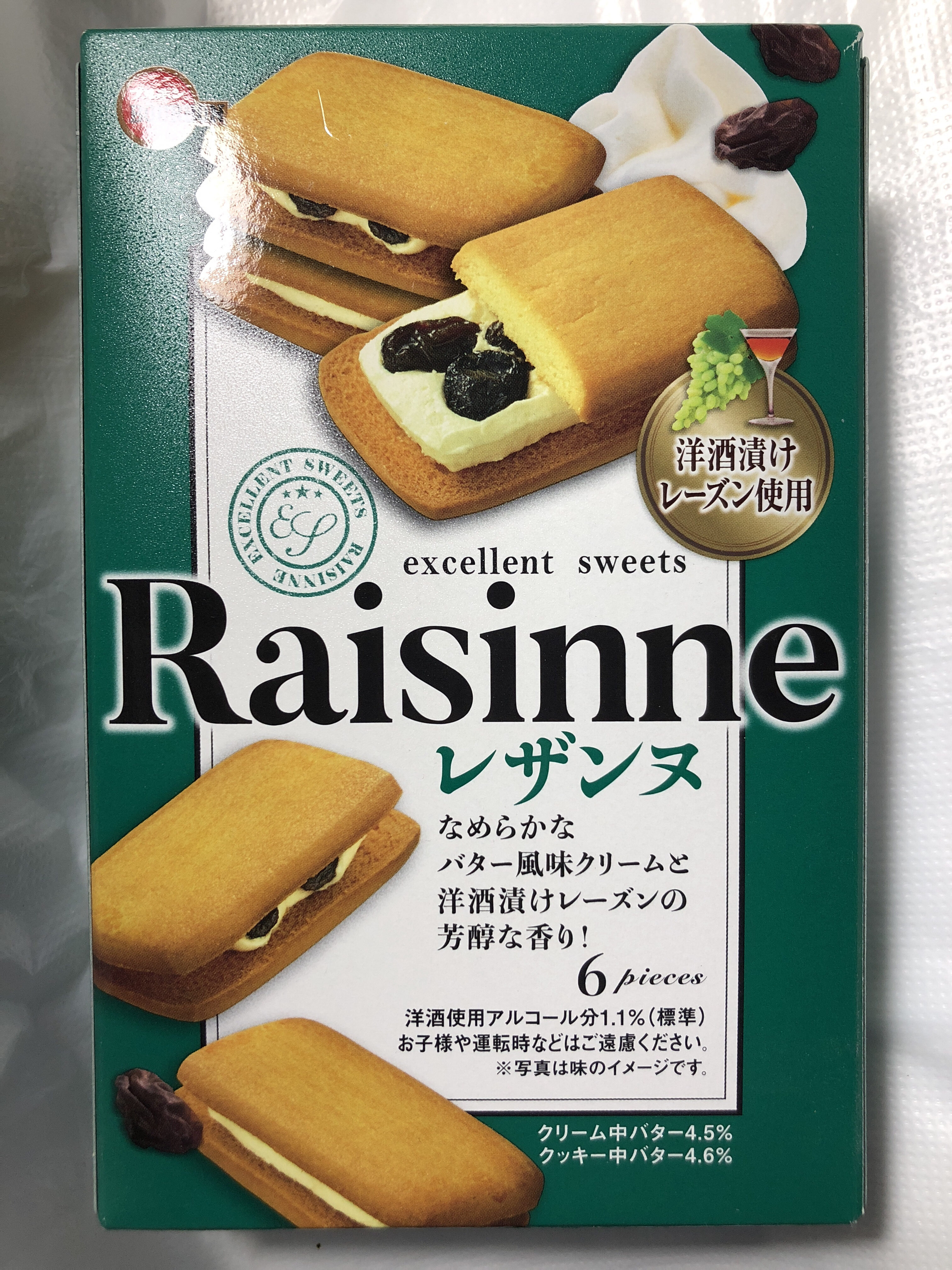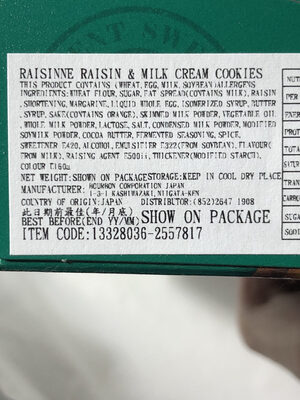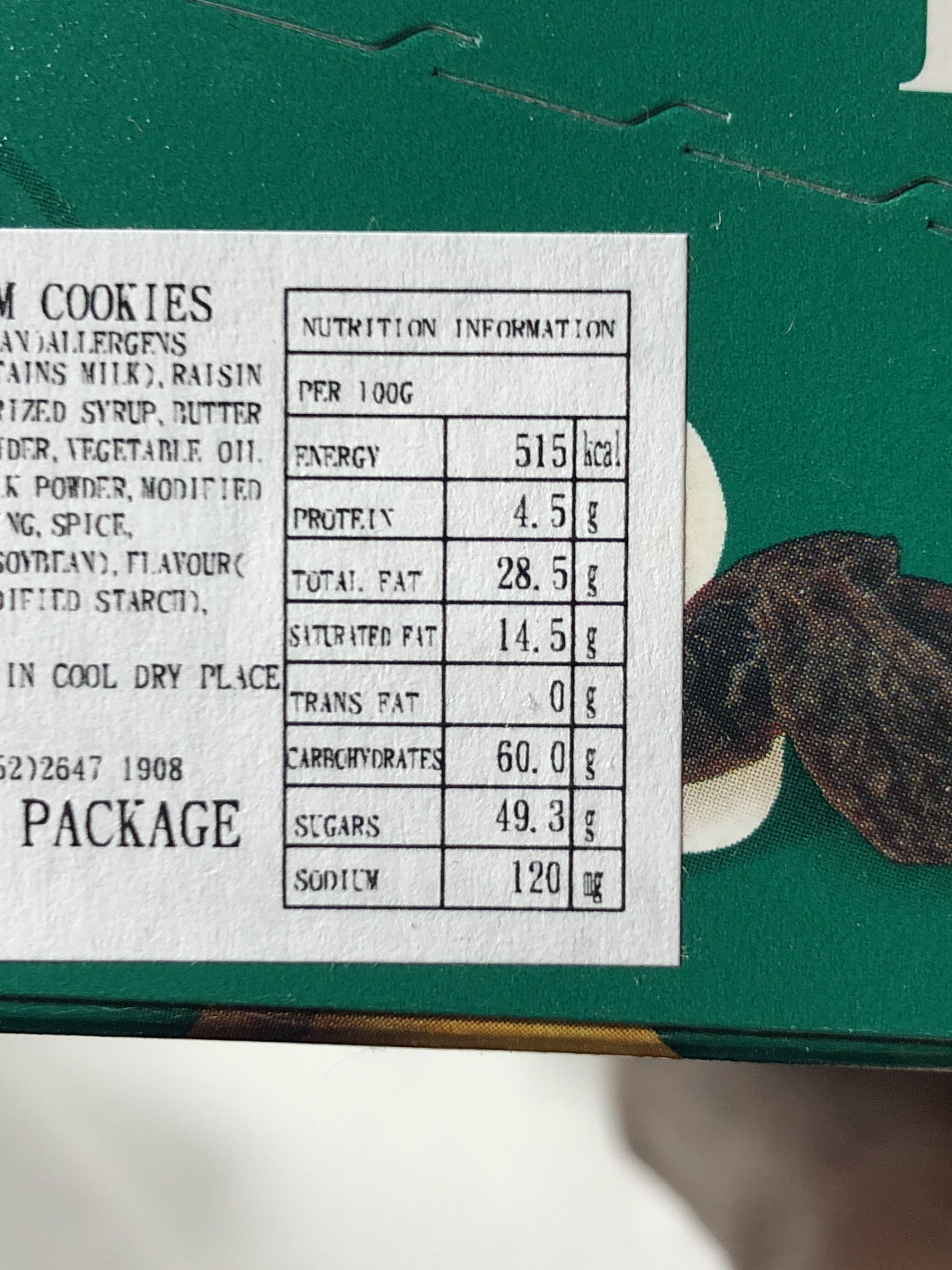帮助我们让食品信息的透明度称为所有人的标准!
作为一个非营利性机构,我们需要依靠您的捐款才能继续向世界各地的消费者报告有关他们食品的信息。
视频革命从你开始!
Raisinne Raisin & Milk Cream Cookies - Bourbon - 6 pieces
匹配您的喜好
健康
成分
-
46 种成分
: WHEAT FLOUR, SUGAR, FAT SPREAD(CONTAINS MILK), RAISIN SHORTENING, MARGARINE, LIQUID WHOLE EGG, ISOMERIZED SYRUP, BUTTER SYRUP, SAKE(CONTAINS ORANGE), SKIMMED MILK POWDER, VEGETABLE OIL, WHOLE MILK POWDER, LACTOSE, SALT, CONDENSED MILK POWDER, MODIFIED SOYMILK POWDER, COCOA BUTTER, FERMENTED SEASONING, SPICE, SWEETENER E420, ALCOHOL, EMULSIFIER E322(FROM SOYBEAN), FLAVOUR( FROM MILK), RAISING AGENT E500ii, THICKENER (MODIFIED STARCH), COLOUR E160a NET WEIGHT:SHOWN ON PACKAGESTORAGE:KEEP IN COOL DRY PLACE HOURRON CORPORATION JAPAN 1-3-1 KASHIWAZAKI, NI IGATA-KEN TRAN MANUFACTURER: DISTRIBUTOR: ( 852)2647 1908 CARBO COUNTRY OF ORIGIN:JAPAN 此日期前最佳(年/月底) BEST BEFORE(END YY MM) SHOW ON PACKAGE ISUGA ITEM CODE:13328036-2557817 SODI过敏原: 麸质, 乳, en:Orange
食品加工
-
超级加工食品
指示产品在 4 - 超加工食品和饮料产品 类中的元素:
- 添加剂: 化製澱粉
- 添加剂: E160a
- 添加剂: E322
- 添加剂: E420
- 成分: 色素
- 成分: Emulsifier
- 成分: 调味剂
- 成分: 乳糖
- 成分: 甜味劑
- 成分: Thickener
添加剂
-
E160a
Carotene: The term carotene -also carotin, from the Latin carota, "carrot"- is used for many related unsaturated hydrocarbon substances having the formula C40Hx, which are synthesized by plants but in general cannot be made by animals -with the exception of some aphids and spider mites which acquired the synthesizing genes from fungi-. Carotenes are photosynthetic pigments important for photosynthesis. Carotenes contain no oxygen atoms. They absorb ultraviolet, violet, and blue light and scatter orange or red light, and -in low concentrations- yellow light. Carotenes are responsible for the orange colour of the carrot, for which this class of chemicals is named, and for the colours of many other fruits, vegetables and fungi -for example, sweet potatoes, chanterelle and orange cantaloupe melon-. Carotenes are also responsible for the orange -but not all of the yellow- colours in dry foliage. They also -in lower concentrations- impart the yellow coloration to milk-fat and butter. Omnivorous animal species which are relatively poor converters of coloured dietary carotenoids to colourless retinoids have yellowed-coloured body fat, as a result of the carotenoid retention from the vegetable portion of their diet. The typical yellow-coloured fat of humans and chickens is a result of fat storage of carotenes from their diets. Carotenes contribute to photosynthesis by transmitting the light energy they absorb to chlorophyll. They also protect plant tissues by helping to absorb the energy from singlet oxygen, an excited form of the oxygen molecule O2 which is formed during photosynthesis. β-Carotene is composed of two retinyl groups, and is broken down in the mucosa of the human small intestine by β-carotene 15‚15'-monooxygenase to retinal, a form of vitamin A. β-Carotene can be stored in the liver and body fat and converted to retinal as needed, thus making it a form of vitamin A for humans and some other mammals. The carotenes α-carotene and γ-carotene, due to their single retinyl group -β-ionone ring-, also have some vitamin A activity -though less than β-carotene-, as does the xanthophyll carotenoid β-cryptoxanthin. All other carotenoids, including lycopene, have no beta-ring and thus no vitamin A activity -although they may have antioxidant activity and thus biological activity in other ways-. Animal species differ greatly in their ability to convert retinyl -beta-ionone- containing carotenoids to retinals. Carnivores in general are poor converters of dietary ionone-containing carotenoids. Pure carnivores such as ferrets lack β-carotene 15‚15'-monooxygenase and cannot convert any carotenoids to retinals at all -resulting in carotenes not being a form of vitamin A for this species-; while cats can convert a trace of β-carotene to retinol, although the amount is totally insufficient for meeting their daily retinol needs.来源: Wikipedia (英语)
-
E322
Lecithin: Lecithin -UK: , US: , from the Greek lekithos, "egg yolk"- is a generic term to designate any group of yellow-brownish fatty substances occurring in animal and plant tissues, which are amphiphilic – they attract both water and fatty substances -and so are both hydrophilic and lipophilic-, and are used for smoothing food textures, dissolving powders -emulsifying-, homogenizing liquid mixtures, and repelling sticking materials.Lecithins are mixtures of glycerophospholipids including phosphatidylcholine, phosphatidylethanolamine, phosphatidylinositol, phosphatidylserine, and phosphatidic acid.Lecithin was first isolated in 1845 by the French chemist and pharmacist Theodore Gobley. In 1850, he named the phosphatidylcholine lécithine. Gobley originally isolated lecithin from egg yolk—λέκιθος lekithos is "egg yolk" in Ancient Greek—and established the complete chemical formula of phosphatidylcholine in 1874; in between, he had demonstrated the presence of lecithin in a variety of biological matters, including venous blood, in human lungs, bile, human brain tissue, fish eggs, fish roe, and chicken and sheep brain. Lecithin can easily be extracted chemically using solvents such as hexane, ethanol, acetone, petroleum ether, benzene, etc., or extraction can be done mechanically. It is usually available from sources such as soybeans, eggs, milk, marine sources, rapeseed, cottonseed, and sunflower. It has low solubility in water, but is an excellent emulsifier. In aqueous solution, its phospholipids can form either liposomes, bilayer sheets, micelles, or lamellar structures, depending on hydration and temperature. This results in a type of surfactant that usually is classified as amphipathic. Lecithin is sold as a food additive and dietary supplement. In cooking, it is sometimes used as an emulsifier and to prevent sticking, for example in nonstick cooking spray.来源: Wikipedia (英语)
-
E420
Sorbitol: Sorbitol --, less commonly known as glucitol --, is a sugar alcohol with a sweet taste which the human body metabolizes slowly. It can be obtained by reduction of glucose, which changes the aldehyde group to a hydroxyl group. Most sorbitol is made from corn syrup, but it is also found in nature, for example in apples, pears, peaches, and prunes. It is converted to fructose by sorbitol-6-phosphate 2-dehydrogenase. Sorbitol is an isomer of mannitol, another sugar alcohol; the two differ only in the orientation of the hydroxyl group on carbon 2. While similar, the two sugar alcohols have very different sources in nature, melting points, and uses.来源: Wikipedia (英语)
-
E500
Sodium carbonate: Sodium carbonate, Na2CO3, -also known as washing soda, soda ash and soda crystals, and in the monohydrate form as crystal carbonate- is the water-soluble sodium salt of carbonic acid. It most commonly occurs as a crystalline decahydrate, which readily effloresces to form a white powder, the monohydrate. Pure sodium carbonate is a white, odorless powder that is hygroscopic -absorbs moisture from the air-. It has a strongly alkaline taste, and forms a moderately basic solution in water. Sodium carbonate is well known domestically for its everyday use as a water softener. Historically it was extracted from the ashes of plants growing in sodium-rich soils, such as vegetation from the Middle East, kelp from Scotland and seaweed from Spain. Because the ashes of these sodium-rich plants were noticeably different from ashes of timber -used to create potash-, they became known as "soda ash". It is synthetically produced in large quantities from salt -sodium chloride- and limestone by a method known as the Solvay process. The manufacture of glass is one of the most important uses of sodium carbonate. Sodium carbonate acts as a flux for silica, lowering the melting point of the mixture to something achievable without special materials. This "soda glass" is mildly water-soluble, so some calcium carbonate is added to the melt mixture to make the glass produced insoluble. This type of glass is known as soda lime glass: "soda" for the sodium carbonate and "lime" for the calcium carbonate. Soda lime glass has been the most common form of glass for centuries. Sodium carbonate is also used as a relatively strong base in various settings. For example, it is used as a pH regulator to maintain stable alkaline conditions necessary for the action of the majority of photographic film developing agents. It acts as an alkali because when dissolved in water, it dissociates into the weak acid: carbonic acid and the strong alkali: sodium hydroxide. This gives sodium carbonate in solution the ability to attack metals such as aluminium with the release of hydrogen gas.It is a common additive in swimming pools used to raise the pH which can be lowered by chlorine tablets and other additives which contain acids. In cooking, it is sometimes used in place of sodium hydroxide for lyeing, especially with German pretzels and lye rolls. These dishes are treated with a solution of an alkaline substance to change the pH of the surface of the food and improve browning. In taxidermy, sodium carbonate added to boiling water will remove flesh from the bones of animal carcasses for trophy mounting or educational display. In chemistry, it is often used as an electrolyte. Electrolytes are usually salt-based, and sodium carbonate acts as a very good conductor in the process of electrolysis. In addition, unlike chloride ions, which form chlorine gas, carbonate ions are not corrosive to the anodes. It is also used as a primary standard for acid-base titrations because it is solid and air-stable, making it easy to weigh accurately.来源: Wikipedia (英语)
-
E500ii - 碳酸氢钠
Sodium carbonate: Sodium carbonate, Na2CO3, -also known as washing soda, soda ash and soda crystals, and in the monohydrate form as crystal carbonate- is the water-soluble sodium salt of carbonic acid. It most commonly occurs as a crystalline decahydrate, which readily effloresces to form a white powder, the monohydrate. Pure sodium carbonate is a white, odorless powder that is hygroscopic -absorbs moisture from the air-. It has a strongly alkaline taste, and forms a moderately basic solution in water. Sodium carbonate is well known domestically for its everyday use as a water softener. Historically it was extracted from the ashes of plants growing in sodium-rich soils, such as vegetation from the Middle East, kelp from Scotland and seaweed from Spain. Because the ashes of these sodium-rich plants were noticeably different from ashes of timber -used to create potash-, they became known as "soda ash". It is synthetically produced in large quantities from salt -sodium chloride- and limestone by a method known as the Solvay process. The manufacture of glass is one of the most important uses of sodium carbonate. Sodium carbonate acts as a flux for silica, lowering the melting point of the mixture to something achievable without special materials. This "soda glass" is mildly water-soluble, so some calcium carbonate is added to the melt mixture to make the glass produced insoluble. This type of glass is known as soda lime glass: "soda" for the sodium carbonate and "lime" for the calcium carbonate. Soda lime glass has been the most common form of glass for centuries. Sodium carbonate is also used as a relatively strong base in various settings. For example, it is used as a pH regulator to maintain stable alkaline conditions necessary for the action of the majority of photographic film developing agents. It acts as an alkali because when dissolved in water, it dissociates into the weak acid: carbonic acid and the strong alkali: sodium hydroxide. This gives sodium carbonate in solution the ability to attack metals such as aluminium with the release of hydrogen gas.It is a common additive in swimming pools used to raise the pH which can be lowered by chlorine tablets and other additives which contain acids. In cooking, it is sometimes used in place of sodium hydroxide for lyeing, especially with German pretzels and lye rolls. These dishes are treated with a solution of an alkaline substance to change the pH of the surface of the food and improve browning. In taxidermy, sodium carbonate added to boiling water will remove flesh from the bones of animal carcasses for trophy mounting or educational display. In chemistry, it is often used as an electrolyte. Electrolytes are usually salt-based, and sodium carbonate acts as a very good conductor in the process of electrolysis. In addition, unlike chloride ions, which form chlorine gas, carbonate ions are not corrosive to the anodes. It is also used as a primary standard for acid-base titrations because it is solid and air-stable, making it easy to weigh accurately.来源: Wikipedia (英语)
分析成分
-
en:May contain palm oil
配料可能含有棕榈油: 植物油
-
非素食
非素食配料: en:Liquid whole egg, 黄油, en:Skimmed milk powder, en:Whole milk powder, 乳糖, 煉奶, 乳有些成分无法识别。
我们需要您的帮助!
您可以通过以下方法帮助我们识别更多的成分,更好地分析本产品及其他产品的成分清单:
- 编辑本产品页面以纠正成分列表中的拼写错误,并/或删除与成分无关的其他语言和句子的成分。
- 添加新的条目,同义词或翻译到我们的多语言的成分列表,成分处理方法和标签。
加入我们的Slack讨论空间 (#ingredients) 和/或了解成分分析在我们的wiki,如果你愿意帮助。谢谢你!
-
en:Vegetarian status unknown
无法识别的配料: en:fat-spread, en:raisin-shortening, 植物牛油, en:isomerized-syrup, en:modified-soymilk-powder, en:e160a-net-weight, en:shown-on-packagestorage, en:keep-in-cool-dry-place-hourron-corporation-japan-1-3-1-kashiwazaki, en:ni-igata-ken-tran-manufacturer, en:distributor, en:852, en:2647-1908-carbo-country-of, en:此日期前最佳, en:年, en:月底, en:best-before, en:end-yy-mm, en:show-on-package-isuga-item-code, en:13328036-2557817-sodi有些成分无法识别。
我们需要您的帮助!
您可以通过以下方法帮助我们识别更多的成分,更好地分析本产品及其他产品的成分清单:
- 编辑本产品页面以纠正成分列表中的拼写错误,并/或删除与成分无关的其他语言和句子的成分。
- 添加新的条目,同义词或翻译到我们的多语言的成分列表,成分处理方法和标签。
加入我们的Slack讨论空间 (#ingredients) 和/或了解成分分析在我们的wiki,如果你愿意帮助。谢谢你!
-
成分分析的详细信息
我们需要您的帮助!
有些成分无法识别。
我们需要您的帮助!
您可以通过以下方法帮助我们识别更多的成分,更好地分析本产品及其他产品的成分清单:
- 编辑本产品页面以纠正成分列表中的拼写错误,并/或删除与成分无关的其他语言和句子的成分。
- 添加新的条目,同义词或翻译到我们的多语言的成分列表,成分处理方法和标签。
加入我们的Slack讨论空间 (#ingredients) 和/或了解成分分析在我们的wiki,如果你愿意帮助。谢谢你!
: WHEAT FLOUR, SUGAR, FAT SPREAD, RAISIN SHORTENING, MARGARINE, LIQUID WHOLE EGG, ISOMERIZED SYRUP, BUTTER, SAKE, SKIMMED MILK POWDER, VEGETABLE OIL, WHOLE MILK POWDER, LACTOSE, SALT, CONDENSED MILK, MODIFIED SOYMILK POWDER, COCOA BUTTER, SEASONING, SPICE, SWEETENER (e420), ALCOHOL, EMULSIFIER (e322 (FROM SOYBEAN)), FLAVOUR (FROM MILK), RAISING AGENT (e500ii), THICKENER (MODIFIED STARCH), COLOUR (e160a NET WEIGHT), SHOWN ON PACKAGESTORAGE (KEEP IN COOL DRY PLACE HOURRON CORPORATION JAPAN 1-3-1 KASHIWAZAKI), NI IGATA-KEN TRAN MANUFACTURER (DISTRIBUTOR, 852), 2647 1908 CARBO COUNTRY OF (此日期前最佳 (年, 月底), BEST BEFORE (END YY MM), SHOW ON PACKAGE ISUGA ITEM CODE), 13328036-2557817 SODI- WHEAT FLOUR -> en:wheat-flour - vegan: yes - vegetarian: yes - ciqual_proxy_food_code: 9410 - percent_min: 3.33333333333333 - percent_max: 100
- SUGAR -> en:sugar - vegan: yes - vegetarian: yes - ciqual_proxy_food_code: 31016 - percent_min: 0 - percent_max: 49.3
- FAT SPREAD -> en:fat-spread - percent_min: 0 - percent_max: 33.3333333333333
- RAISIN SHORTENING -> en:raisin-shortening - percent_min: 0 - percent_max: 25
- MARGARINE -> en:margarine - percent_min: 0 - percent_max: 20
- LIQUID WHOLE EGG -> en:liquid-whole-egg - vegan: no - vegetarian: yes - ciqual_food_code: 22000 - percent_min: 0 - percent_max: 16.6666666666667
- ISOMERIZED SYRUP -> en:isomerized-syrup - percent_min: 0 - percent_max: 14.2857142857143
- BUTTER -> en:butter - vegan: no - vegetarian: yes - ciqual_proxy_food_code: 16400 - percent_min: 0 - percent_max: 12.5
- SAKE -> en:sake - vegan: maybe - vegetarian: yes - ciqual_food_code: 1026 - percent_min: 0 - percent_max: 11.1111111111111
- SKIMMED MILK POWDER -> en:skimmed-milk-powder - vegan: no - vegetarian: yes - ciqual_food_code: 19054 - percent_min: 0 - percent_max: 10
- VEGETABLE OIL -> en:vegetable-oil - vegan: yes - vegetarian: yes - from_palm_oil: maybe - percent_min: 0 - percent_max: 9.09090909090909
- WHOLE MILK POWDER -> en:whole-milk-powder - vegan: no - vegetarian: yes - ciqual_food_code: 19021 - percent_min: 0 - percent_max: 8.33333333333333
- LACTOSE -> en:lactose - vegan: no - vegetarian: yes - percent_min: 0 - percent_max: 7.69230769230769
- SALT -> en:salt - vegan: yes - vegetarian: yes - ciqual_food_code: 11058 - percent_min: 0 - percent_max: 0.3
- CONDENSED MILK -> en:condensed-milk - vegan: no - vegetarian: yes - ciqual_proxy_food_code: 19051 - percent_min: 0 - percent_max: 0.3
- MODIFIED SOYMILK POWDER -> en:modified-soymilk-powder - percent_min: 0 - percent_max: 0.3
- COCOA BUTTER -> en:cocoa-butter - vegan: yes - vegetarian: yes - ciqual_food_code: 16030 - percent_min: 0 - percent_max: 0.3
- SEASONING -> en:coating - vegan: maybe - vegetarian: maybe - percent_min: 0 - percent_max: 0.3
- SPICE -> en:spice - vegan: yes - vegetarian: yes - percent_min: 0 - percent_max: 0.3
- SWEETENER -> en:sweetener - percent_min: 0 - percent_max: 0.3
- e420 -> en:e420 - vegan: yes - vegetarian: yes - percent_min: 0 - percent_max: 0.3
- ALCOHOL -> en:alcohol - vegan: maybe - vegetarian: yes - ciqual_food_code: 1014 - percent_min: 0 - percent_max: 0.3
- EMULSIFIER -> en:emulsifier - percent_min: 0 - percent_max: 0.3
- e322 -> en:e322 - vegan: maybe - vegetarian: maybe - percent_min: 0 - percent_max: 0.3
- FROM SOYBEAN -> en:soya-bean - vegan: yes - vegetarian: yes - ciqual_food_code: 20901 - percent_min: 0 - percent_max: 0.3
- e322 -> en:e322 - vegan: maybe - vegetarian: maybe - percent_min: 0 - percent_max: 0.3
- FLAVOUR -> en:flavouring - vegan: maybe - vegetarian: maybe - percent_min: 0 - percent_max: 0.3
- FROM MILK -> en:milk - vegan: no - vegetarian: yes - ciqual_proxy_food_code: 19051 - percent_min: 0 - percent_max: 0.3
- RAISING AGENT -> en:raising-agent - percent_min: 0 - percent_max: 0.3
- e500ii -> en:e500ii - vegan: yes - vegetarian: yes - percent_min: 0 - percent_max: 0.3
- THICKENER -> en:thickener - percent_min: 0 - percent_max: 0.3
- MODIFIED STARCH -> en:modified-starch - vegan: yes - vegetarian: yes - ciqual_proxy_food_code: 9510 - percent_min: 0 - percent_max: 0.3
- COLOUR -> en:colour - percent_min: 0 - percent_max: 0.3
- e160a NET WEIGHT -> en:e160a-net-weight - percent_min: 0 - percent_max: 0.3
- SHOWN ON PACKAGESTORAGE -> en:shown-on-packagestorage - percent_min: 0 - percent_max: 0.3
- KEEP IN COOL DRY PLACE HOURRON CORPORATION JAPAN 1-3-1 KASHIWAZAKI -> en:keep-in-cool-dry-place-hourron-corporation-japan-1-3-1-kashiwazaki - percent_min: 0 - percent_max: 0.3
- NI IGATA-KEN TRAN MANUFACTURER -> en:ni-igata-ken-tran-manufacturer - percent_min: 0 - percent_max: 0.3
- DISTRIBUTOR -> en:distributor - percent_min: 0 - percent_max: 0.3
- 852 -> en:852 - percent_min: 0 - percent_max: 0.15
- 2647 1908 CARBO COUNTRY OF -> en:2647-1908-carbo-country-of - percent_min: 0 - percent_max: 0.3
- 此日期前最佳 -> en:此日期前最佳 - percent_min: 0 - percent_max: 0.3
- 年 -> en:年 - percent_min: 0 - percent_max: 0.3
- 月底 -> en:月底 - percent_min: 0 - percent_max: 0.15
- BEST BEFORE -> en:best-before - percent_min: 0 - percent_max: 0.15
- END YY MM -> en:end-yy-mm - percent_min: 0 - percent_max: 0.15
- SHOW ON PACKAGE ISUGA ITEM CODE -> en:show-on-package-isuga-item-code - percent_min: 0 - percent_max: 0.1
- 此日期前最佳 -> en:此日期前最佳 - percent_min: 0 - percent_max: 0.3
- 13328036-2557817 SODI -> en:13328036-2557817-sodi - percent_min: 0 - percent_max: 0.3
营养
-
营养质量不好
⚠ ️警告:未指定纤维数量,它们对营养等级可能的正向贡献或许不被考虑在内。⚠ ️警告:标签上没有注明水果、蔬菜和坚果的含量,它是根据配料表估计的: 0在计算营养分数时,产品是否不被认为是饮料
积极点: 0
- 蛋白质: 2 / 5 (值: 4.5, 四舍五入值: 4.5)
- 纤维: 0 / 5 (值: 0, 四舍五入值: 0)
- 水果,蔬菜,坚果,油菜/核桃/橄榄油: 0 / 5 (值: 2.3047129317888e-05, 四舍五入值: 0)
消极点: 27
- 能量: 6 / 10 (值: 2155, 四舍五入值: 2155)
- 糖: 10 / 10 (值: 49.3, 四舍五入值: 49.3)
- 饱和脂肪: 10 / 10 (值: 14.5, 四舍五入值: 14.5)
- 钠: 1 / 10 (值: 120, 四舍五入值: 120)
蛋白质的分数不计算,因为负的分数大于或等于11。
营养评分: (27 - 0)
营养分数:
-
营养水平
-
脂肪在最高含量中 (28.5%)
您需要了解的内容- 大量摄入脂肪,尤其是饱和脂肪,会升高胆固醇,从而增加患心脏病的风险。
推荐: 减少脂肪和饱和脂肪的摄入- 选择脂肪和饱和脂肪含量较低的产品。
-
饱和脂肪在最高含量中 (14.5%)
您需要了解的内容- 大量摄入脂肪,尤其是饱和脂肪,会升高胆固醇,从而增加患心脏病的风险。
推荐: 减少脂肪和饱和脂肪的摄入- 选择脂肪和饱和脂肪含量较低的产品。
-
糖在最高含量中 (49.3%)
您需要了解的内容- 大量摄入糖类会导致体重增加和诱发蛀牙。它还会增加患 2 型糖尿病和心血管疾病的风险。
推荐: 限制食糖和含糖饮料的消费- 应尽可能限制含糖饮料(如苏打水、果汁饮料、果汁和蜂蜜)的饮用(每天不超过 1 杯)。
- 选择含糖量较低的产品,减少含糖产品的消费。
-
食盐在中等数量中 (0.3%)
您需要了解的内容- 大量摄入盐(或钠)会导致高血压,从而增加患心脏病和中风的几率。
- 因为通常没有症状,很多高血压患者并不知道自己患有高血压。
- 大多数人摄入过多的盐(平均每天 9 至 12 克),约是建议最大摄入量的两倍。
推荐: 控制盐和腌制类食物的摄入- 减少烹饪时盐的用量,也不要在吃饭时再次加盐。
- 限制咸味零食的食用,并选择含盐量较低的产品。
-
-
营养成分
营养成分 已售出的
对于 100 克 / 100 毫升与它比较:: 面饼 蛋白质 4.5 g -32% 脂肪 28.5 g +22% 饱和脂肪 14.5 g +26% 碳水化合物 60 g -6% 糖 49.3 g +78% 食盐 0.3 g -49%
环境影响
-
生态得分 B - 低环境影响
⚠ ️交通运输对贵国的全面影响目前尚不清楚。Eco-Score 是实验分数,用于总结食品对环境的影响。→ Eco-Score 最初适用于法国,随后推广到欧洲其他国家。Eco-Score 计算公式会定期更新改进,以提高在各个国家的适应性和精确性。生命周期分析
-
同类产品的平均影响值: B (Score: 69/100)
分类: Biscuit (cookie)
分类: Biscuit (cookie)
- PEF 环境评分: 0.35 (分数越低,影响越小)
- 包括对气候变化的影响: 2.88 千克二氧化碳当量/千克产品
阶段 影响 农业
80.5 %加工
11.8 %包装
3.1 %运输
3.2 %分派
1.4 %消耗量
0.0 %
加分与减分
-
成分来源具有高度影响
减分:
环保政策: +3
运输: 0
产品和/或其成分的来源 成分列表 影响 日本 100 %中度
-
包装具有低度影响
减分: -1
形状 材料 循坏利用 影响 Box 22 PAP 低
此产品的 Eco-Score
-
对本产品的影响: B (Score: 71/100)
产品: Raisinne Raisin & Milk Cream Cookies - Bourbon - 6 pieces
生命周期分析得分: 69
加分与减分的总和: -1
最终得分:: 71/100
-
碳足迹
-
等于汽油汽车行驶 1.5 公里
每 100 克产品含 288 g CO²
碳排放数据来自ADEME的 Agribalyse 数据库,其类别如下: Biscuit (cookie) (资料来源:ADEME Agribalyse Database)
阶段 影响 农业
82.9 %加工
7.9 %包装
3.8 %运输
4.7 %分派
0.7 %消耗量
0.0 %
运输
-
成分来源
成分来源具有高度影响
产品和/或其成分的来源 成分列表 影响 日本 100 %中度
Report a problem
-
Incomplete or incorrect information?
Category, labels, ingredients, allergens, nutritional information, photos etc.
If the information does not match the information on the packaging, please complete or correct it. Open Food Facts is a collaborative database, and every contribution is useful for all.
数据来源
添加产品 由 scholes8
上次修改产品页面时间 由 packbot.
产品页面已被修改 ecoscore-impact-estimator.










